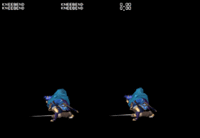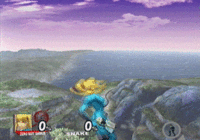Auto-canceling: Difference between revisions
Serpent King (talk | contribs) mNo edit summary |
mNo edit summary |
||
| Line 11: | Line 11: | ||
==Trivia== | ==Trivia== | ||
*The forward airs of {{SSBM|Donkey Kong}} in ''Melee'', and of {{SSBB|Donkey Kong}} and {{SSBB|Ganondorf}} in ''Brawl'', cannot be auto-cancelled during their ending frames. By exploring the code of the games and looking at the underlying properties of the moves, it has been discovered that the developers had intended for auto-cancelling those moves to be possible; however, due to a minor error (the accidental use of the wrong type of timing function), it is not possible to auto-cancel those moves. | *The forward airs of {{SSBM|Donkey Kong}} in ''Melee'', and of {{SSBB|Donkey Kong}} and {{SSBB|Ganondorf}} in ''Brawl'', cannot be auto-cancelled during their ending frames. By exploring the code of the games and looking at the underlying properties of the moves, it has been discovered that the developers had intended for auto-cancelling those moves to be possible; however, due to a minor error (the accidental use of the wrong type of timing function), it is not possible to auto-cancel those moves. | ||
{{AllGames|Techniques}} | {{AllGames|Techniques}} | ||
Revision as of 09:09, August 21, 2015


Auto-canceling is the act of landing during the beginning or ending frames of an aerial attack, thereby circumventing the landing lag that would have occurred had the character instead landed during the middle of that attack's animation.
Auto-canceling an attack produces no more landing lag than a regular landing from an ordinary jump (of which the landing lag tends to be around 4-6 frames, a very short amount of time), whereas landing during the middle of an aerial attack almost always results in a significant delay before the character can act (raise a shield, jump, dodge, etc.) again. Most aerial attacks can be auto-cancelled during both the first few frames and the last few frames of the attack's animation; however, some attacks cannot be auto-cancelled at the start, at the end, or even at all. Each individual aerial attack for every character has a specific auto-cancelling window (or lack thereof) that must be memorized and practiced.
Auto-canceling can be very beneficial to players using characters with laggy aerial attacks, as this can reduce the amount of landing lag produced, and create more time for the character to act, potentially avoiding being punished during the move's landing lag. Precise auto-canceling of aerials is also frequently needed for performing followups and combos, so as to leave less time for the opponent to react and escape. Learning and practicing the timing required to auto-cancel all of a character's aerial attacks is especially important in Super Smash Bros. Brawl and Super Smash Bros. 4, due to the lack of L-cancelling in those games.
Trivia
- The forward airs of Donkey Kong in Melee, and of Donkey Kong and Ganondorf in Brawl, cannot be auto-cancelled during their ending frames. By exploring the code of the games and looking at the underlying properties of the moves, it has been discovered that the developers had intended for auto-cancelling those moves to be possible; however, due to a minor error (the accidental use of the wrong type of timing function), it is not possible to auto-cancel those moves.
